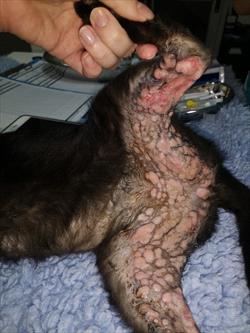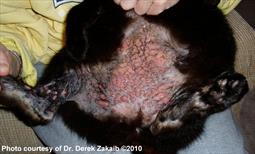What is a Granuloma?
A granuloma is a solid grouping of inflammatory cells growing together in a lump or solid structure.
What is an Eosinophil?
An eosinophil is a type of white blood cell that is activated in the body during allergic responses or parasites are present. Eosinophil counts often go up on a blood test when a pet has fleas or worms or when an allergy is flaring up. Eosinophils can circulate in the blood and enter the tissues. They are part of the immune system and are on patrol for biochemical signals from tissue cells telling them that a parasite has invaded. Eosinophils activate when they receive these signals and release chemicals to attack the parasite. Unfortunately, they may activate when benign or harmless materials like pollen, dust, etc. come into contact with the body, and in this allergy example, they release inflammatory chemicals inappropriately. This causes itching, swelling, redness, and other signs of allergy.
The eosinophil has a characteristic appearance under the microscope due to the pink staining granules. The pink staining granules contain assorted toxins and biochemicals designed to attack an invading parasite. These granules can be thought of as small bombs directed against large invading organisms such as worms.
Severe Cutaneous Eosinophilic Plaque Lesions, Cat (Photograph)

Diagnosis confirmed with biopsy. Courtesy Dr. Beatriz Lago.
What is the Eosinophilic Granuloma Complex?
Given the above information, it would seem logical that an eosinophilic granuloma would be a granuloma made up of eosinophils; however, the situation is more complicated. Initially, it appeared that eosinophilic granuloma was just what it sounds like but as it was studied more thoroughly, it was found that there were three different classes of this condition, and not all were granulomas and not all involved eosinophils. Furthermore, the name eosinophilic granuloma implies a final diagnosis, but this is generally not the case, either. Eosinophilic granuloma lesions are more like symptoms of a variety of underlying causes such as allergy or even bacterial infection.
The three classes of eosinophilic granuloma complex are listed below. An individual cat may have any or all of them.
The three classes are:
- the indolent ulcer
- the eosinophilic plaque
- the eosinophilic granuloma
These conditions are felt to most commonly have an underlying allergic basis though it is not always possible to determine what that allergic basis might be. The presence of any of the three above conditions does not definitively imply any specific type of allergy. In fact, there is some evidence that some cases begin as simple allergic reactions to an external substance but when internal skin proteins are released by scratching, the reaction continues to involve these “self” proteins as well.

An external view of YumYum's indolent, or rodent, ulcer. Photo by Dr. Wendy Brooks
The Indolent Ulcer (also called the rodent ulcer)
Numerous eosinophilic plaques on the ventral abdomen

Cats with indolent ulcers have an erosion on the margin of their upper lip. Sometimes, a proliferative eroded structure also develops on the tongue so if your cat has a classical lip ulcer, it is a good idea to open the cat's mouth and check.
eos gran fat chin.jpeg - Caption. [Optional]
![eos gran fat chin.jpeg - Caption. [Optional] White cat with very green eyes and affected lower lip/chin area that is very swollen on one side.](/AppUtil/Image/handler.ashx?imgid=7840682)
Cat with an affected bottom lip/chin area. Photo courtesy of Dr. Valerie Fadok, DVM, PhD, ACVD
Yum Yum 1

YumYum shows his rodent ulcer. Photo by Dr. Wendy Brooks
In general, the appearance of the indolent ulcer is classical and a biopsy is not needed; though occasionally these are precancerous conditions and a biopsy may be needed to rule out a malignant skin tumor. If allowed to go untreated, the ulcer can be very destructive to the upper lip. Even after treatment, the ulcer will likely heal but the area of the lip that has been destroyed will not grow back and the cat's face will be permanently altered.
The Eosinophilic Plaque
This lesion typically looks like a raised thickened raw area of skin usually on the belly, inner thigh, anal, or throat area. Cats with these lesions are commonly extremely itchy. A microscope slide pressed onto the affected area often picks up numerous eosinophils that can be detected under the microscope (the cytology test), thus confirming this condition. Often bacteria can be identified with cytology as well, suggesting that infection can contribute to these lesions. Cats with this condition generally have increased circulating eosinophils in their bloodstreams as well.
The Eosinophilic Granuloma
The eosinophilic granuloma, which is also called linear granuloma or collagenolytic granuloma, produces a classical swollen lower lip or chin or a classical long, narrow lesion running down the back of the thigh. Sometimes proliferations grow from the actual footpads where they ulcerate as the cat is forced to walk on them. There is some tendency for this condition to occur in adolescent kittens though it can occur at any age.
What is Happening to These Cats?
Cat Paw

Foot pad proliferation is a less common form of eosinophilic granuloma. Photo by Dr. Wendy Brooks
Linear granuloma

Pink lower lip swelling represents the eosinophilic granuloma. Photo by Dr. Wendy Brooks
The eosinophilic granuloma complex represents a disorder of eosinophil function. The eosinophil’s real job is to attack parasites. It is designed to be attracted to areas where parasitism is occurring and once there it releases biochemicals to destroy the invading creature. In cats with eosinophilic granuloma complex, eosinophils are called to the site of an allergic response, and the biochemicals released cause damage to local collagen. As mentioned, the reaction can include “self” proteins as well as external ones. The eosinophilic granuloma patterns, as specific as they can be, do not point to a specific cause. The most common cause is some kind of allergy, and treatment is generally about trying to determine the specifics of the allergy and suppress that reaction.
Diagnosis and Treatment
The best approach is to try and find the underlying allergy, but determining what the cat is allergic to is often easier said than done and takes time.
Refractory lesions are lesions that don't respond to treatment and are another story.
A biopsy may be needed to confirm the diagnosis of eosinophilic granuloma; tumors or other ulcerative lesions may mimic the eosinophilic granuloma complex. Biopsy may reveal less obvious underlying causes such as Demodex mites or ringworm, a type of fungi. Keep in mind eosinophilic granuloma is an inflammatory reaction to proteins deemed invaders by the eosinophils.
After diagnosis, treatments might include:
- A more aggressive steroid course.
- A food allergy diet trial to determine if a food allergy is the underlying source of inflammation. Remember that it is impossible to completely control the diet of a cat that roams outdoors.
- A trial course of aggressive flea control.
- Serum or skin testing for airborne allergies.
- A trial course of antibiotics.
- A trial course of cyclosporine. Cyclosporine has assorted anti-inflammatory properties, which could be of benefit.
Other treatments that have been used when other options have failed include doxycycline (an antibiotic with anti-inflammatory properties), gold therapy (yes, oral medications using gold have been used with mixed success in inflammatory conditions), removing the lesion via laser or cryotherapy, and daily high dose interferon-alpha.
Occasionally, lesions may become infected and E-collars are sometimes needed to prevent licking and further damage to the skin.
Prognosis (Outcome)
The eosinophilic granuloma is not a well-understood condition, and again, the success of treatment depends on finding and treating any underlying causes. The prognosis is excellent if the underlying disease is found and treated effectively. Cats on steroids like prednisone or similar medications must be monitored closely for side effects over time.
It can sometimes be challenging to strike a balance to keep your cat’s signs in check. It is important to keep recheck appointments and follow your veterinarian’s medication and monitoring directions so your cat can have the best chance at a healthy and hopefully more comfortable life.
Learn more about flea control products.
Learn more about food allergy.
Learn more about inhalant allergy.